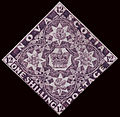History of Nova Scotia: Difference between revisions
Hantsheroes (talk | contribs) Undid revision 402761187 by 97.83.15.251 (talk) |
Hantsheroes (talk | contribs) |
||
| Line 52: | Line 52: | ||
During [[King Georges War]], fortress Louisbourg was [[Siege of Louisbourg (1745)|captured]] by [[American colonial forces]] in 1745, then returned by the British to France in 1748. |
During [[King Georges War]], fortress Louisbourg was [[Siege of Louisbourg (1745)|captured]] by [[American colonial forces]] in 1745, then returned by the British to France in 1748. |
||
== Halifax established == |
|||
Even after the official war, conflict in Nova Scotia continued on unofficially before the [[French and Indian War]] was declared. Despite the [[Siege of Port Royal|Conquest of Acadia]] in 1710, Nova Scotia was settled primarily by Catholic Mi'kmaq and Acadians. To prevent the establishment of Protestant settlements in the region, Mi'kmaq raided the early British settlements of present-day [[Shelburne, Nova Scotia|Shelburne]] (1715) and [[Canso, Nova Scotia|Canso]] (1720). A generation later, the British firmly established Protestants in the colony by building a new capital [[City of Halifax|Halifax]] (1749) along with Dartmouth (1750) and Lunenburg (1753). 'Again, to stop the Protestant migration into Nova Scotia, the Catholics - Acadians and Natives - repeatedly raided the new Protestant settlements (See [[Raid on Dartmouth (1751)]] and [[Raid on Lunenburg (1756)]]). At this time, Mi'kmaq and Acadians were also involved in the [[Siege of Grand Pre]] (1749) and the Mi'kmaq were at the [[Battle at St. Croix]] (1750). |
Even after the official war, conflict in Nova Scotia continued on unofficially before the [[French and Indian War]] was declared. (One historian has referred to this period of conflict as [[Father Le Loutre’s War]].<ref>John Grenier. The Far Reaches of Empire. Oklahoma University Press. 2008.</ref>) Despite the [[Siege of Port Royal|Conquest of Acadia]] in 1710, Nova Scotia was settled primarily by Catholic Mi'kmaq and Acadians. To prevent the establishment of Protestant settlements in the region, Mi'kmaq raided the early British settlements of present-day [[Shelburne, Nova Scotia|Shelburne]] (1715) and [[Canso, Nova Scotia|Canso]] (1720). A generation later, the British firmly established Protestants in the colony by building a new capital [[City of Halifax|Halifax]] (1749) along with Dartmouth (1750) and Lunenburg (1753). 'Again, to stop the Protestant migration into Nova Scotia, the Catholics - Acadians and Natives - repeatedly raided the new Protestant settlements (See [[Raid on Dartmouth (1751)]] and [[Raid on Lunenburg (1756)]]). At this time, Mi'kmaq and Acadians were also involved in the [[Siege of Grand Pre]] (1749) and the Mi'kmaq were at the [[Battle at St. Croix]] (1750). |
||
=== French and Indian War === |
=== French and Indian War === |
||
Revision as of 10:30, 18 December 2010

Nova Scotia (also known as Mi'kma'ki and Acadia) is a Canadian province located in Canada's Maritimes. The region was initially occupied by Mi'kmaq. During the first 150 years of European settlement, the colony was primarily made up of Catholic Acadians and Mi'kmaq. This time period involved four colonial wars between Britain and France before Britain defeated France in North America. Throughout these wars, Nova Scotia was the site of numerous battles, raids and skimmishes. The Conquest of Acadia happened in 1710. Just prior to the last colonial war - the French and Indian War - the capital was moved from Annapolis Royal, Nova Scotia to the newly founded Halifax, Nova Scotia. After the colonial wars, New England Planters and Foreign Protestants settled Nova Scotia. After the American Revolution, the colony was settled by Loyalists. During the eighteenth century, Nova Scotia became self-governing in 1848 and joined the Canadian Confederation in 1867.
Mi'kmaq
The oldest evidence of humans in Nova Scotia indicates the Paleo-Indians were the first, approximately 11,000 years ago. Natives are believed to have been present in the area between 1,000 and 5,000 years ago. Mi'kmaq, the First Nations of the province and region, are their direct descendants.
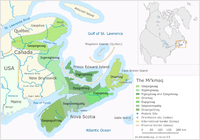
The Mi'kmaq (previously spelled Micmac in English texts) are a First Nations people, indigenous to the Maritime Provinces, the Gaspé Peninsula Quebec and northeastern New England. Míkmaw is the singular form of Míkmaq.
In 1616 Father Biard believed the Mi'kmaq population to be in excess of 3,000. However, he remarked that, because of European diseases, including smallpox and alcoholism, there had been large population losses in the previous century.
The Mi'kmaq were originally allies with other nearby Algonquian nations including the Abenaki, forming the seven nation Wabanaki Confederacy, pronounced Template:IPA-alg; this was later expanded to eight with the ceremonial addition of Great Britain at the time of the 1749 treaty. At the time of contact with the French (late 16th century) they were expanding from their Maritime base westward along the Gaspé Peninsula /St. Lawrence River at the expense of Iroquioian Mohawk tribes, hence the Mi'kmaq name for this peninsula, Gespedeg ("last-acquired"). They were amenable to limited French settlement in their midst, but as France lost control of Acadia in the early 18th century, they soon found themselves overwhelmed by British (English, Irish, Scottish, Welsh) who seized much of the land without payment and deported the French. Later on the Mi'kmaq also settled Newfoundland as the unrelated Beothuk tribe became extinct.
Seventeenth Century
Port Royal established
The first European settlement in Nova Scotia was established almost more than a century later in 1605. The French, led by Pierre Dugua, Sieur de Monts established the first capital for the colony Acadia at Port Royal.[1] Other than a few trading posts around the province, for the next seventy-five years, Port Royal was virtually the only European settlement in Nova Scotia. Port Royal (later renamed Annapolis Royal) remained the capital of Acadia and later Nova Scotia for almost 150 years, prior to the founding of Halifax in 1749.
The first Scottish settlement in the Americas was Nova Scotia (1621). Eight years later, in 1629, Sir William Alexander established the first Scottish settlement at Port Royal. The colony's charter, in law, made Nova Scotia (defined as all land between Newfoundland and New England) a part of mainland Scotland. In 1631, under King Charles I, the Treaty of Suza returned Nova Scotia to the French.
Approximately seventy-five years after Port Royal was founded, Acadians migrated from the capital and established what would become the other major Acadian settlements before the Expulsion of the Acadians: Grand Pré, Chignecto, Cobequid and Pisiguit.
Until the Conquest of Acadia, the English made six attempts to conquer Acadia by defeating the capital. They finally defeated the French in the Siege of Port Royal (1710). Over the following fifty years, the French and their allies made six unsuccessful military attempts to regain the capital.
Civil War
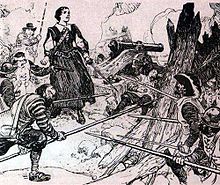
During this time, Acadia was plunged into what some historians have described as a civil war in Acadia (1640–1645). The war was between Port Royal, where Governor of Acadia Charles de Menou d'Aulnay de Charnisay was stationed, and present-day Saint John, New Brunswick, where Charles de Saint-Étienne de la Tour was stationed.[2]
In the war, there were four major battles. la Tour attacked d'Aulnay at Port Royal in 1640.[3] In response to the attack, D'Aulnay sailed out of Port Royal to establish a five month blockade of La Tour's fort at Saint John, which La Tour eventually defeated (1643). La Tour attacked d'Aulnay again at Port Royal in 1643. d'Aulnay and Port Royal ultimately won the war against La Tour with the 1645 siege of Saint John.[4] After d'Aulnay died (1650), La Tour re-established himself in Acadia.
King William's War
There were four colonial wars - the French and Indian Wars - between New England and New France before the British defeated the French in North America. During these wars, Nova Scotia/ Acadia was on the border and experienced many military conflicts. The first colonial war was King William's War.
During King William's War, military conflicts in Nova Scotia included: Battle of Port Royal (1690); Battle at Guysborough; a naval battle in the Bay of Fundy (Action of 14 July 1696); and the Raid on Chignecto (1696). At the end of the war England returned the territory to France in the Treaty of Ryswick.
Eighteenth Century
Queen Anne's War
The second colonial war was Queen Anne's War. During Queen Anne's War, military conflicts in Nova Scotia included: Raid on Grand Pre; Siege of Port Royal (1707); and the Siege of Port Royal (1710) and the Battle of Bloody Creek (1711).
During Queen Anne's War, the Conquest of Acadia (1710) was confirmed by the Treaty of Utrecht of 1713. At this time the British Empire considered present-day New Brunwick as part of Nova Scotia. France retained possession of Île St Jean (Prince Edward Island) and Île Royale (Cape Breton Island), on which it established a fortress at Louisbourg to guard the sea approaches to Quebec.
Dummer's War
During the excalation that proceed Dummer's War (1722–1725), Mi'kmaq raided the new fort at Canso, Nova Scotia (1720). Under potential siege, in May 1722, Lieutenant Governor John Doucett took 22 Mi'kmaq hostage at Annapolis Royal to prevent the capital from being attacked.[5] In July 1722 the Abenaki and Mi'kmaq created a blockade of Annapolis Royal, with the intent of starving the capital.[6] The natives captured 18 fishing vessels and prisoners from present-day Yarmouth to Canso. They also seized prisoners and vessels from the Bay of Fundy.

As a result of the escalating conflict, Massachusetts Governor Samuel Shute officially declared war on July 22, 1722.[7] The first battle of Dummer's War happened in the Nova Scotia theatre.[8] In response to the blockade of Annapolis Royal, at the end of July 1722, New England lauched a campaign to end the blockade and retrive over 86 New England prisoners taken by the natives. One of these operations resulted in the Battle at Jeddore.[9] The next was a raid on Canso in 1723.[10] Then in July 1724 when a group of sixty Mikmaq and Maliseets raided Annapolis Royal.[11]
The treaty that ended the war marked a significant shift in European relations with the Mi'kmaq and Maliseet. For the first time a European Empire formally acknowledged that its domininion over Nova Scotia would have to be negotiated with the region's indigenous inhabitants. The treaty was invoked as recently as 1999 in the Donald Marshall case.[12]
King Georges War
The third colonial war was King Georges War. During King Georges War, military conflicts in Nova Scotia included: Raid on Canso; Siege of Annapolis Royal (1744); the Siege of Louisbourg (1745); the Duc d'Anville Expedition and the Battle of Grand Pré. During King Georges War, fortress Louisbourg was captured by American colonial forces in 1745, then returned by the British to France in 1748.
Halifax established
Even after the official war, conflict in Nova Scotia continued on unofficially before the French and Indian War was declared. (One historian has referred to this period of conflict as Father Le Loutre’s War.[13]) Despite the Conquest of Acadia in 1710, Nova Scotia was settled primarily by Catholic Mi'kmaq and Acadians. To prevent the establishment of Protestant settlements in the region, Mi'kmaq raided the early British settlements of present-day Shelburne (1715) and Canso (1720). A generation later, the British firmly established Protestants in the colony by building a new capital Halifax (1749) along with Dartmouth (1750) and Lunenburg (1753). 'Again, to stop the Protestant migration into Nova Scotia, the Catholics - Acadians and Natives - repeatedly raided the new Protestant settlements (See Raid on Dartmouth (1751) and Raid on Lunenburg (1756)). At this time, Mi'kmaq and Acadians were also involved in the Siege of Grand Pre (1749) and the Mi'kmaq were at the Battle at St. Croix (1750).
French and Indian War

The forth and final colonial war was the French and Indian War. During the war, military conflicts in Nova Scotia included: Battle of Fort Beauséjour; Bay of Fundy Campaign (1755); the Battle of Petitcodiac; the Raid on Lunenburg (1756); the Louisbourg Expedition (1757); Battle of Bloody Creek (1757); Siege of Louisbourg (1758), Petitcodiac River Campaign, Gulf of St. Lawrence Campaign (1758), St. John River Campaign, and Battle of Restigouche.
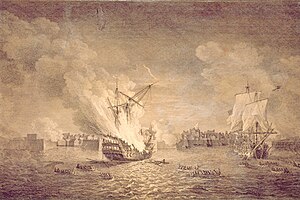
The British Conquest of Acadia happened in 1710. Over the next forty-five years the Acadians refused to sign an unconditional oath of allegiance to Britain. During this time period Acadians participated in various militia operations against the British and maintained vital supply lines to the French Fortress of Louisbourg and Fort Beausejour.[14]
During the French and Indian War, the British sought to neutralize any military threat Acadians posed and to interrupt the vital supply lines Acadians provided to Louisbourg by deporting Acadians from Acadia.[15]
The British began the Expulsion of the Acadians with the Bay of Fundy Campaign (1755). Over the next nine years over 12,000 Acadians were removed from Nova Scotia.[16] During the various campaigns of the expulsion, the Acadian and Native resistance to the British intensified.
The war ended and Britain had gained control over the entire Maritime region.
New England Planters
Between 1759 and 1768, about 8,000 New England Planters responded to Governor Charles Lawrence's request for settlers from the New England colonies.
American Revolution
Throughout the war, American privateers devastated the maritime economy by raiding many of the coastal communities. There were constant attacks by American privateers,[17] such as the Raid on Lunenburg (1782), numerous raids on Liverpool, Nova Scotia (October 1776, March 1777, September, 1777, May 1778, September 1780) and a raid on Annapolis Royal, Nova Scotia (1781).[18]
American Privateers also raided Canso, Nova Scotia (1775). In 1779, American privateers returned to Canso and destroyed the fisheries, which were worth £50,000 a year to Britain.[19]
To guard against such attacks, the 84th Regiment of Foot (Royal Highland Emigrants) was garrisoned at forts around the Atlantic Canada. Fort Edward (Nova Scotia) in Windsor, Nova Scotia was the Regiment's headquarters to prevent a possible American land assault on Halifax from the Bay of Fundy. There was an American attack on Nova Scotia by land, the Battle of Fort Cumberland.
In 1781, as a result of the Franco-American alliance against Great Britain, there was also a naval engagement with a French fleet at Sydney, Nova Scotia, near Spanish River, Cape Breton.[20]
In 1784 the western, mainland portion of the colony was separated and became the province of New Brunswick, and the territory in Maine entered the control of the newly independent American state of Massachusetts. Cape Breton Island became a separate colony in 1784 only to be returned to Nova Scotia in 1820.
Loyalists
As a result of the British defeat in the American Revolution, approximately 30,000 United Empire Loyalists (American Tories) left the thirteen colonies and settled in Nova Scotia. Of these 30,000, 14,000 went to present-day New Brunswick and 16,000 went to Nova Scotia. Approximately 3,000 of this group were Black Loyalists.[21]
Nineteenth Century
War of 1812
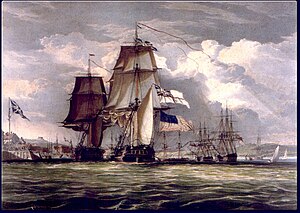
During the War of 1812, Nova Scotia’s contribution to the war effort was communities either purchasing or building various privateer ships to seize American vessels.[22] Three members of the community of Lunenburg, Nova Scotia purchased a privateer schooner and named it Lunenburg on August 8, 1814.[23] The Nova Scotian privateer vessel captured seven American vessels. The Liverpool Packet from Liverpool, Nova Scotia was another Nova Scotia privateer vessel that caught over fifty ships in the war - the most of any privateer in Canada.
Perhaps the most dramatic moment in the war for Nova Scotia was the HMS Shannon's led the captured American Frigate USS Chesapeake into Halifax Harbour (1813). Many of the prisoners were kept at Deadman's Island, Halifax.
The Black Refugees from the War of 1812 were African American slaves who fought for the British and were relocated to Nova Scotia. The Black Refugees were the second group of African Americans, after the Black Loyalists, to defect to the British side and be relocated to Nova Scotia.
Responsible government
Nova Scotia was the first colony in British North America and in the British Empire to achieve responsible government in January–February 1848 and become self-governing through the efforts of Joseph Howe.
-
Nova Scotia postage stamp (1851-1857). Printed in England. Also used in New Brunswick.
-
Nova Scotia stamp (issued 1860)
American Civil War
Thousands of Nova Scotians fought in the American Civil War (1861-1865), primarily for the North. [24] The British Empire (including Nova Scotia) was declared neutral in the struggle between the North and the South. As a result, Britain (and Nova Scotia) continued to trade with both the South and the North. Nova Scotia’s economy boomed during the civil war. To counter trade with the South, the North created a naval blockade. This blockade created tension between Britain and the North. Many blockade runners made their way back and forth between Halifax and the South. Nova Scotia was the site of two international incidents during the war: the Chesapeake Affair and the escape from Halifax Harbour of Confederate John Taylor Wood on the CSS Tallahassee.
The war left many fearful that the North might attempt to annex British North America, particularly after the Fenian raids began. In response, volunteer regiments were raised across Nova Scotia. One of the main reasons why Britain sanctioned the creation of Canada (1867) was to avoid another possible conflict with America and to leave the defence of Nova Scotia to a Canadian Government.[25]
Anti-Confederation campaign
Pro-Confederate premier Charles Tupper led Nova Scotia into the Canadian Confederation on July 1, 1867, along with New Brunswick and the Province of Canada.
The Anti-Confederation Party was led by Joseph Howe. Almost three months later, in the election of September 18, 1867, the Anti-Confederation Party, won 18 out of 19 federal seats, and 36 out of 38 seats in the provincial legislature. A motion passed by the Nova Scotia House of Assembly in 1868 refusing to recognise the legitimacy of Confederation has never been rescinded. With the great Hants County bi-election of 1869, Howe was successful in turning the province away from appealing confederation to simply seeking "better terms" within it. Repeal, as anti-confederation became known, would rear its head again in the 1880s, and transform into the Maritime Rights Movement in the 1920s. Some Nova Scotia flags flew at half mast on Dominion Day as late as that time.
Golden age of sail

Nova Scotia became a world leader in both building and owning wooden sailing ships in the second half of the century. Nova Scotia produced internationally recognized ship builders Donald McKay and William Dawson Lawrence. Notable ships included the barque Stag, a clipper renowned for speed and the ship William D. Lawrence, the largest wooden ship ever built in Canada. The fame Nova Scotia achieved from sailors was assured when Joshua Slocum became the first man to sail single-handedly around the world (1895). This international attention continued into the following century with the many racing victories of the Bluenose schooner.
Nova Scotia was also the birthplace and home of Samuel Cunard, a British shipping magnate, born at Halifax, Nova Scotia, who founded the Cunard Line.
Twentieth Century
First World War
During World War I, Halifax became a major international port and naval facility. The harbour became a major shipment point for war supplies, troop ships to Europe from Canada and the United States and hospital ships returning the wounded. These factors drove a major military, industrial and residential expansion of the city.[26]
On Thursday, December 6, 1917, when the city of Halifax, Nova Scotia, Canada, was devastated by the huge detonation of a French cargo ship, fully loaded with wartime explosives, that had accidentally collided with a Norwegian ship in "The Narrows" section of the Halifax Harbour. Approximately 2,000 people (mostly Canadians) were killed by debris, fires, or collapsed buildings, and it is estimated that over 9,000 people were injured.[27] This is still the world's largest man-made accidental explosion.[28]
See also
References
- ^ Also, that same year, French fishermen established a settlement at Canso.
- ^ M. A. MacDonald, Fortune & La Tour: The civil war in Acadia, Toronto: Methuen. 1983
- ^ Brenda Dunn, p. 19
- ^ Brenda Dunn. A History of Port Royal, Annapolis Royal: 1605-1800. Nimbus Publishing, 2004. p. 20
- ^ Grenier, p. 56
- ^ Beamish Murdoch. History of Nova Scotia or Acadia, p. 399
- ^ A history of Nova-Scotia, or Acadie, Volume 1, by Beamish Murdoch, p. 398
- ^ The Nova Scotia theatre of the Dummer War is named the "Mi'kmaq-Maliseet War" by John Grenier. The Far Reaches of Empire: War in Nova Scotia 1710-1760. University of Oklahoma Press. 2008.
- ^ Beamish Murdoch. A history of Nova-Scotia, or Acadie, Volume 1, p. 399; Geoffery Plank, An Unsettled Conquest, p. 78
- ^ Benjamin Church, p. 289; John Grenier, p. 62
- ^ Faragher, John Mack, A Great and Noble Scheme New York; W. W. Norton & Company, 2005. pp. 164-165; Brenda Dunn, p. 123
- ^ William Wicken. Mi'kmaq Treaties on Trial. 2002. pp. 72-72.
- ^ John Grenier. The Far Reaches of Empire. Oklahoma University Press. 2008.
- ^ John Grenier, Far Reaches of Empire: War in Nova Scotia 1710-1760. Oklahoma Press. 2008
- ^ Stephen E. Patterson. "Indian-White Relations in Nova Scotia, 1749-61: A Study in Political Interaction." Buckner, P, Campbell, G. and Frank, D. (eds). The Acadiensis Reader Vol 1: Atlantic Canada Before Confederation. 1998. pp.105-106.; Also see Stephen Patterson, Colonial Wars and Aboriginal Peoples, p. 144.
- ^ Ronnie-Gilles LeBlanc (2005). Du Grand Dérangement à la Déportation: Nouvelles Perspectives Historiques, Moncton: Université de Moncton, 465 pages ISBN 1897214022 (book in French and English). The Acadians were scattered across the Atlantic, in the Thirteen Colonies, Louisiana, Quebec, Britain and France. (See Jean-François Mouhot (2009) Les Réfugiés acadiens en France (1758-1785): L'Impossible Réintégration?, Quebec, Septentrion, 456 p. ISBN 2894485131; Ernest Martin (1936) Les Exilés Acadiens en France et leur établissement dans le Poitou, Paris, Hachette, 1936). Very few eventually returned to Nova Scotia (See John Mack Faragher (2005). A Great and Noble Scheme: The Tragic Story of the Expulsion of the French Acadians from their American Homeland, New York: W.W. Norton, 562 pages ISBN 0-393-05135-8 online excerpt).
- ^ Benjamin Franklin also engaged France in the war, which meant that many of the privateers were also from France.
- ^ Roger Marsters (2004). Bold Privateers: Terror, Plunder and Profit on Canada's Atlantic Coast" , p. 87-89.
- ^ Lieutenant Governor Sir Richard Hughes stated in a dispatch to Lord Germaine that "rebel cruisers" made the attack.
- ^ Thomas B. Akins. (1895) History of Halifax. Dartmouth: Brook House Press.p. 82
- ^ About a third of whom soon moved themselves to Sierra Leone in 1792 via the Committee for the Relief of the Black Poor, becoming the Original settlers of Freetown. As well, Large numbers of Gaelic-speaking Highland Scots emigrated to Cape Breton and the western part of the mainland during the late 18th century and 19th century. In 1812 Sir Hector Maclean (the 7th Baronet of Morvern and 23rd Chief of the Clan Maclean) emigrated to Pictou from Glensanda and Kingairloch in Scotland with almost the entire population of 500. Sir Hector is buried in the cemetery at Pictou.
- ^ John Boileau. Half-hearted Enemies: Nova Scotia, New England and the War of 1812. Halifax: Formac Publishing. 2005. p.53
- ^ C.H.J.Snider, Under the Red Jack: privateers of the Maritime Provinces of Canada in the War of 1812 (London: Martin Hopkinson & Co. Ltd, 1928), 225-258 (see http://www.1812privateers.org/Ca/canada.htm#LG)
- ^ Marquis, Greg. In Armageddon’s Shadow: The Civil War and Canada’s Maritime Provinces. McGill-Queen’s University Press. 1998.
- ^ Marquis, Greg. In Armageddon’s Shadow: The Civil War and Canada’s Maritime Provinces. McGill-Queen’s University Press. 1998.
- ^ The Halifax Explosion and the Royal Canadian Navy John Armstrong, University of British Columbia Press, 2002, p.10-11.
- ^ CBC - Halifax Explosion 1917
- ^ Jay White, "Exploding Myths: The Halifax Explosion in Historical Context", Ground Zero: A Reassessment of the 1917 explosion in Halifax Alan Ruffman and Colin D. Howell editors, Nimbus Publishing (1994), p. 266
Bibliography
- History of Nova Scotia, for Schools By Duncan Campbell BiblioLife, 2009 ISBN 1115659804
- The quest of the folk : antimodernism and cultural selection in twentieth-century Nova Scotia BY Ian McKay McGill-Queen's University Press, 1994 ISBN 0773511792
- Conservative reformer, 1804-1848 - v. 2. The Briton becomes Canadian BY Joseph Howe and J. Murray Beck McGill-Queen's University Press, 1984 ISBN 0773504451
- The Supreme Court of Nova Scotia, 1754-2004: from imperial bastion to ...By Philip Girard, Jim Phillips Society for Canadian Legal History, 2004 ISBN 0802080219
- Against the Grain: Foresters and Politics in Nova Scotia By Anders Sandberg, Peter Clancy UBC Press, 2000 ISBN 0774807652

